Posts filed under "Avatar"
February 7, 2017
Open Source Lucasfilm’s Habitat Restoration Underway
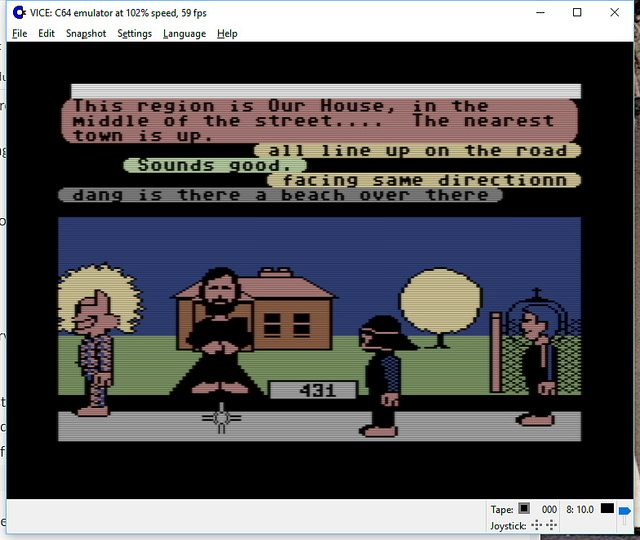
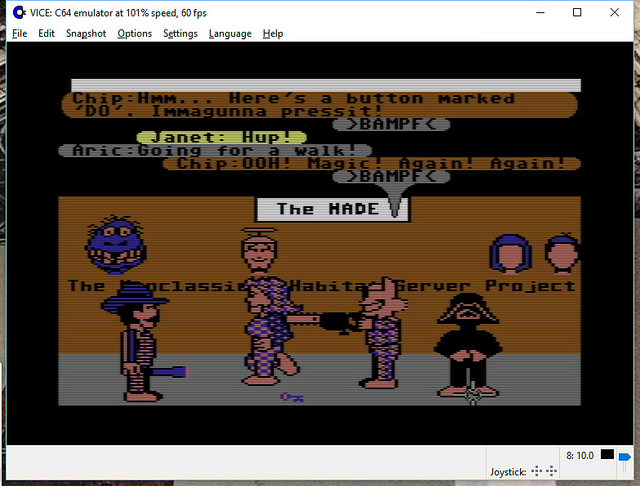
It’s all open source!
Yes – if you haven’t heard, we’ve got the core of the first graphical MMO/VW up and running and the project needs help with code, tools, doc, and world restoration.
I’m leading the effort, with Chip leading the underlying modern server: the Elko project – the Nth generation gaming server, still implementing the basic object model from the original game.
http://neohabitat.org is the root of it all.
http://slack.neohabitat.org to join the project team Slack.
http://github.com/frandallfarmer/neohabitat to fork the repo.
To contribute, you should be capable to use a shell, fork a repo, build it, and run it. Current developers use: shell, Eclipse, Vagrant, or Docker.
To get access to the demo server (not at all bullet proofed) join the project.
We’ve had people from around the world in there already! (See the photos)
http://neohabitat.org #opensource #c64 #themade
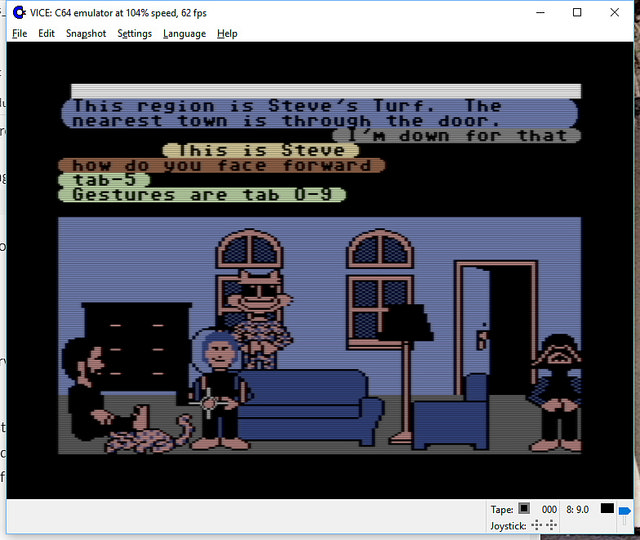
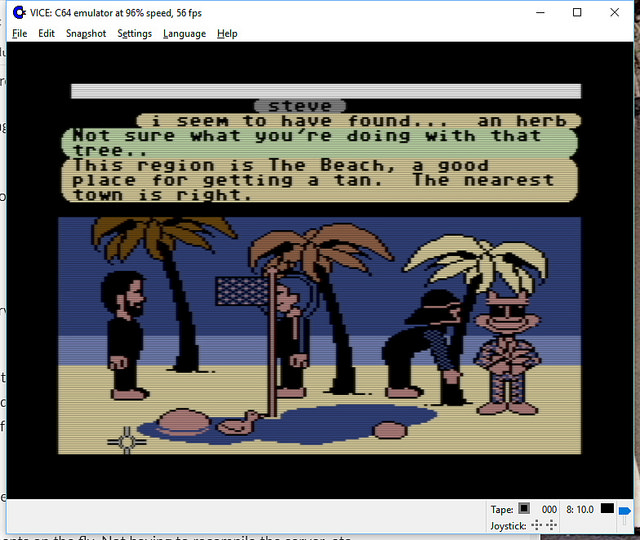
December 19, 2013
Audio version of classic “BlockChat” post is up!
On the Social Media Clarity Podcast, we’re trying a new rotational format for episodes: “Stories from the Vault” – and the inaugural tale is a reading of the May 2007 post The Untold History of Toontown’s SpeedChat (or BlockChattm from Disney finally arrives)
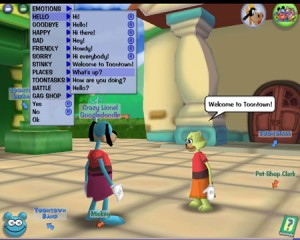
Link to podcast episode page[sc_embed_player fileurl=”http://traffic.libsyn.com/socialmediaclarity/138068-disney-s-hercworld-toontown-and-blockchat-tm-s01e08.mp3″]
August 23, 2013
Patents and Software and Trials, Oh My! An Inventor’s View
What does almost 20 years of software patents yield? You’d be surprised!
I gave an Ignite talk (5 minutes: 20 slides advancing every 15 seconds) entitled
“Patents and Software and Trials, Oh My! An Inventor’s View”
Here’s some improved links…
-
I’ve created ip-reform.org to support the “I Won’t Sign Bogus Patents” pledge.
-
Encourage your company to adopt Twitter’s Inventor’s Patent Agreement
-
Support the The EFF on Patent Reform – DefendInnovation.org has a proposal
-
Sequestration has delayed a bay area PTO office, support this bill
I gave the talk twice, and the second version is also available (shows me giving the talk and static versions of my slides…) – watch that here:
March 23, 2011
SM Pioneers: Farmer & Morningstar – How Gamers Made us More Social
Shel Israel has just posted @Global Neighbourhoods the latest in his series of posts from his upcoming book Pioneers of Social Media – which includes an interview with us about our contributions over the last 30+ years…
How Gamers Made us More Social
Many of us often overlook the role that games have played in creating social media. They provided much of the technology that we use today, not to mention a certain attitude. Of greatest importance, is that it was on games that people started socializing with each other in large numbers, online and in public. It was in games that people started to self-organize to get complex jobs accomplished.
We had people meeting and sharing and talking and performing tasks several years before we even had the Worldwide Web.
We’re honored to be amongst those highlighted. Shel says about 100 folks will be included. There won’t be enough pages, but we eagerly look forward to the result none-the-less.
August 18, 2009
Do You Wanna Date My Avatar
Things sure have changed since the early days, when people debated if the term Avatar was too geeky…
August 10, 2008
Lucasfilm's Habitat Promotional Video
With the coverage in the NYT – I thought people might like to see what the original avatars looked like – here’s a promotional video from 1986:

Funny what has, and has not, changed in over 20 years.
September 13, 2004
The Avatar is Legal Voting Age
I finally got around to scanning my copy of the first print reference for the use of the term Avatar to represent a user’s graphical online presence.
Definition Habitat: A make-believe world inhabited by small, colorful creatures, called Avatars. Human beings may visit Habitat and move freely about its regions, interacting at will with with Avatars. Human beings reach Habitat by traveling many miles through tiny telephone lines and entering through a large gateway, called QuantumLink. Once a human being enters Habitat, he or she takes on the visual form of an Avatar, and for all intents and purposes becomes one of these new-world beings. In the world of Habitat, people can play games and go on quests, but mainly they meet other people and have fun. — Run Magazine, August 1986 (full text transcription)
The Avatar just turned 18.
[Update July 06, 2008 by Randy]
A client provided me with another historical link to a 1986 article in Compute Magazine that has been archived online: Habitat: A Look At The Future Of Online Games by Kathy Yakal.
In the extended entry are the scans of the page of the screen shots (linked from the archive)…
July 15, 2004
The Business of Social Avatar Virtual Worlds
Or, why I really like Second Life, even if their business is most likely doomed.
There, Inc. recently announced that they are winding down their consumer service to focus on external contracts (read: Government simulation and ramping up their platform business). This sort of repositioning is all-too-familiar to Chip and me. Radical shifts like these usually signal the beginning of the end.
Here’s a riddle:
What do you get when you combine three failed dotcoms?
Answer:
A really, really big crater.
Electric Communities (a.k.a. Communities.com) made similar business strategy shifts when we abandoned our too-big-too-slow-too-soon-solution-without-an-acknowledged-problem secure distributed world EC Habitats/Microcosm in favor of leveraging assets then recently acquired in a 3-way merger with OnLive! and The Palace, Inc. After our attempt to capitalize on delivering advertisements to Palace users failed, we then repositioned once again as a multi-user interactive media production company. Those are pretty big shifts, and the people working at EC didn’t possess the needed skills to succeed at a complete transformation of two different businesses.
We’ll see if There can weather a shift of this magnitude. Though, history doesn’t bode well:
| A history of the business of social avatar worlds | |
|---|---|
| World | Business Disposition |
| Habitat/Club Caribe | Succeeded (when services charged $.06/minute) |
| WorldsAway | Business failed (after services went flat-rate) |
| ECHabitats/Microcosm | Never shipped, abandoned |
| The Palace | Business failed. Twice. |
| There | First Business (social) failed, platform business TBD |
| Second Life | TBD |
Many other miserable failures were omitted from this table for brevity.
These products all had avatars with animated gestures, virtual economies with scarcity and real-estate, the last three had user-uploaded textures, two even had user-programmable objects. For the first four projects, Chip and I had a significant hand in their development, repositioning, and/or deployment, so we’ve been down this road many time before. I’ve done some UI consulting work for Second Life.
Lessons applied
In the Lessons of Lucasfilm’s Habitat, we prescribed certain lessons about virtual worlds. During the 90’s, we followed our own advice on several projects. The architects of many other virtual worlds took our words to heart as well. The Palace founders (later acquired by Communities.com) and Second Life architects made a point to tell us so.
In fact, Second Life embodies several of the original lessons almost to a fault, specifically:
- Communications bandwidth is a scarce resource.
- The implementation platform is relatively unimportant.
- Detailed central planning is impossible; don’t even try.
- And especially our Future Directions section which said to let the users create the content – both the world and objects.
Communications bandwidth is a scarce resource.
A future post will detail why this is true as much as ever, but I find it interesting how There and Second Life each applied this lesson: There ignored it (in the sense of client graphic bandwidth) and selected a rendering design that required a high-powered graphics card, processor, and a fairly beefy Internet connection. Of the 5 machines I own, exactly 0 are officially compatible (I have to hack my way around the hardware check.) This choked off their customer base from the start.
Second Life was designed to run on a broader range of graphic hardware, but used streaming technology (the Founder was a RealAudio engineer) to attempt to combat the bandwidth issues. On the graphics side, they decided to use the minimum set of features they could get away with from an open standard: Open GL. This allowed them to apply another lesson like no one had before…
The implementation platform is relatively unimportant
In Habitat Redux, we basically recant this lesson, indicating that there now is a standard platform – MS-Windows + The Internet + The Web browser. It seemed to us that a universe of protocol-only compatible virtual world clients could be built, but the compromises required (lowest common denominator graphics and sound no common UI conventions, etc.) and the extra development time would mean that no one would make the investment to implement that for a stand-alone application. Certainly not for a social virtual world. With EC Habitats we tried (using Java as our core for the client), but it only made the application too slow to use. But, lo and behold! 5 years later – here comes Second Life: a proof of concept for this principle.
Detailed central planning is impossible; don’t even try.
Future Directions: Let the users build it, all of it.
In Chip’s most recent post he writes about how we discovered significant hidden costs related to user generated content. Let’s call the sample instance of the context problem: "Oh! There’s a penis on your sweater!"
Fortunately, There saw this problem coming and decided to charge people a fee to moderate their uploaded content, a move that seemed to make complete sense. We still don’t know if this portion of the business was break-even, so the jury is out on the viability of this solution. It certainly wasn’t enough to make the company profitable.
Second Life instead decided to make their service adult-only to dodge the problem of kids being exposed to uncontrolled content. They also let users create arbitrary 3D objects out of primitives, add scripts, provide communications conduits to off-site services, provide virtual real state with user landscaping, and run it all on top of a physics simulator.
OMG! Second Life is the system the original Lessons of Habitat described. The Graphical Mud Xanadu. How could it do anything but succeed?
Second life has the smallest active population of any virtual world platform on my list even though they continue to innovate and enable more and more sophisticated user-created-content.

I loved it when I was unemployed. It was nothing but fun and intellectual challenge to produce an invisible teleporting 100-round-per-minute auto-cannon that ripped havoc throughout the WWII online community that settled there. Creating a Blade Runner blimp that traveled the world and handed out teleport cards to the city of Little Tokyo meanwhile playing a custom Japanese audio track was the highlight of my citizenship.
But, as soon as I got a job, I stopped creating, and then I stopped playing.
This wasn’t a big surprise to me. I mentioned above that I did some UI consulting work for Second Life. Linden knew that the 1.0 platform was content-producer-centric and they needed to reorient their interface to accommodate content consumers: Those who would come in and enjoy all the wonderful content generated by folks like their early adopters (and me). I helped them design a new UI, which has been implemented over the last 8 months or so. It does almost eve
rything I re
commended and a lot of other great stuff, like maps of the most popular locations, events, and objects and land for sale.
But where are the consumers? Where are the folks who will pay to participate in all this great (and not so great) user produced content? We built it, why aren’t they coming?
Because available online time is a limited resource and …
- users who are gamers play MMORPGs, and web-games and need that structure.
- user who aren’t gamers are used to either…
- visual entertainment being delivered to them and/or
- chat-like interaction being low-overhead, mostly IM.
Loading a large a client, traveling a virtual geography with an awkward avatar, looking at a map to find and interact with people, and experimenting with a bunch of user-generated experiences of varying quality is just too heavyweight for people who are used to Television, Instant Messaging and Email.
It’s like comparing cell phones and video phones: We’ve had the capability for home video phones for over a decade but we don’t use them because we don’t need them. They only add very little incremental value and introduce a bunch of overhead and complication. On the other hand, cell phones took over in a shorter time because they significantly increased the utility of what a phone was already good at: Connecting people for immediate conversation. Interestingly enough, camera/cel phones can now send movies using the same technology that the picture-phones had. The big difference is that the camera is movies (pictures) are recorded separately from the conversation, which is a model that has much greater utility.
Where does that leave us? Are social/avatar virtual worlds doomed to business extinction? Is there any way services like Second Life can make it?
Perhaps.
Focusing on the problems at hand: Consumers want to be fed content, they may even pay for it and a good platform can enable many talented people to create content, it seems that the main missing components are a way to identify and promote the content the consumers want and a create way to deliver it to them with the least possible burden on the consumer’s part.
If Second Life can accomplish this, they will be the first. I wish them the best of luck!
See my earlier post about a different path that avatars have taken.






